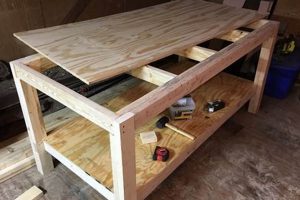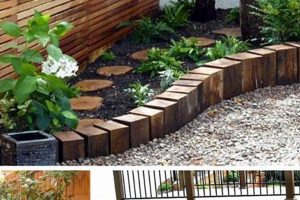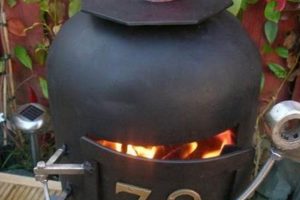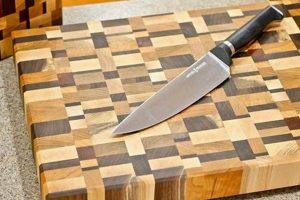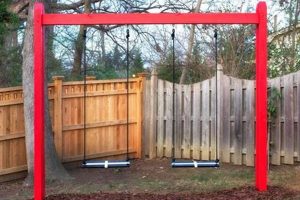Wooden representations of snowmen, often crafted as do-it-yourself projects, constitute a seasonal decorative art form. These creations typically involve cutting, shaping, and painting wood to resemble snowmen figures. Examples range from simple freestanding shapes to more complex constructions incorporating multiple wooden components and embellishments such as painted features, fabric scarves, and twig arms.
The appeal of these wooden snowmen lies in their accessibility, affordability, and potential for personalization. Creating such decorations allows for individual expression and offers a sustainable alternative to mass-produced ornaments. Historically, crafting seasonal decorations has provided a means of engaging in festive activities and fostering a sense of community, with wooden snowmen representing a tangible manifestation of winter traditions.
The following discussion will delve into specific techniques for constructing durable and visually appealing winter-themed wooden figures, exploring considerations for material selection, design variations, and finishing methods to ensure longevity and aesthetic appeal. Furthermore, it will examine safety precautions essential during the construction process.
Tips for Crafting Durable Winter Figures
The following guidelines offer crucial insights for producing long-lasting and aesthetically pleasing winter-themed wooden figures, specifically those depicting snowmen. Adhering to these principles ensures the finished product withstands seasonal conditions and maintains its visual appeal for years to come.
Tip 1: Select Appropriate Wood Species: Opt for wood types known for their weather resistance and minimal warping. Cedar, redwood, or treated pine are suitable choices. Avoid softer, more porous woods unless they are adequately sealed and protected.
Tip 2: Ensure Proper Sealing and Priming: Before painting, apply a high-quality wood sealant to all surfaces. This prevents moisture absorption, which can lead to cracking and decay. Follow the sealant with a primer specifically designed for exterior use.
Tip 3: Utilize Weather-Resistant Paints: Employ paints formulated for outdoor applications. Acrylic latex paints are generally recommended for their durability and resistance to fading. Apply multiple thin coats for optimal protection.
Tip 4: Reinforce Joints and Connections: When constructing multi-piece figures, use waterproof wood glue and durable fasteners such as screws or dowels. This strengthens the connections and prevents separation due to temperature fluctuations or physical stress.
Tip 5: Incorporate Drainage Features: If the figure is designed with hollow sections or areas where water can accumulate, include drainage holes to prevent water from pooling and causing rot. Position these holes discreetly to maintain the figure’s aesthetic appeal.
Tip 6: Secure Ground Anchoring: For freestanding figures intended for outdoor display, implement a robust anchoring system to prevent them from being toppled by wind or other environmental factors. Metal stakes or weighted bases provide effective stabilization.
Tip 7: Consider UV Protection: Ultraviolet radiation can degrade paint and wood over time. Apply a clear UV-resistant coating to the finished figure to mitigate fading and extend its lifespan. Reapply the coating periodically as needed.
Following these tips enhances the longevity and visual appeal of crafted winter figures. Choosing the right materials, preparing surfaces correctly, and constructing robust connections will yield decorations capable of withstanding seasonal elements, ensuring their continued enjoyment for years to come.
The subsequent sections will examine various design options for creating unique and personalized wooden snowmen, exploring techniques for adding intricate details and customizing their appearance to suit individual preferences.
1. Material Selection
Material selection is paramount in the creation of wooden snowmen, directly impacting the durability, aesthetic appeal, and overall longevity of the finished piece. The chosen wood species and associated materials dictate the figure’s resistance to environmental factors and influence the ease with which it can be crafted and finished.
- Wood Species and Weather Resistance
The selection of wood species is critical for outdoor display. Softwoods like pine are readily available and easy to work with, but require thorough sealing and protection against moisture. Hardwoods, such as oak or cedar, offer greater natural resistance to decay and insect infestation, reducing the need for extensive treatment. Untreated, non-weather-resistant wood will deteriorate rapidly when exposed to rain, snow, and sunlight.
- Paint Adhesion and Surface Preparation
The surface characteristics of the chosen wood affect paint adhesion. Smooth, close-grained woods like maple provide an ideal surface for paint application, requiring minimal preparation. Open-grained woods like oak may necessitate filling to create a smooth base for paint. Proper sanding and priming are essential regardless of the wood species, ensuring that the paint adheres evenly and resists peeling or cracking.
- Fastener Compatibility and Structural Integrity
When constructing multi-piece wooden snowmen, the choice of fasteners must align with the selected wood. Softwoods require careful selection of screws or nails to prevent splitting, while hardwoods may necessitate pre-drilling to avoid damage. The size and type of fasteners used directly influence the structural integrity of the figure, ensuring that it remains intact under stress from wind or handling.
- Sealants and Protective Coatings
The application of sealants and protective coatings is integral to preserving the wood and the applied finish. Oil-based sealants penetrate the wood, providing water resistance from within, while polyurethane coatings offer a durable, scratch-resistant surface. The selection of appropriate sealants and coatings extends the lifespan of the wooden snowman, protecting it from the damaging effects of moisture, UV radiation, and physical abrasion.
In summary, material selection profoundly influences the quality and longevity of winter-themed wooden figures. The careful consideration of wood species, paint compatibility, fastener compatibility, and protective coatings ensures that the finished product not only possesses aesthetic appeal but also withstands the rigors of outdoor display, maintaining its integrity for years to come. Neglecting these considerations can result in rapid deterioration and diminished aesthetic value.
2. Design Complexity
Design complexity in the context of wooden snowman projects significantly impacts the required skill level, resource investment, and ultimate visual appeal. A straightforward design, perhaps involving a simple, two-dimensional cutout, demands minimal carpentry skills and limited material consumption. In contrast, a complex design, incorporating three-dimensional features, intricate detailing, and articulated joints, necessitates advanced woodworking techniques, specialized tools, and a greater allocation of time and materials. For example, a basic silhouette requires only a jigsaw and paint, while a snowman with carved features, layered clothing, and posable arms would mandate chisels, power carvers, and potentially even rudimentary engineering considerations for joint stability. The complexity directly affects the project’s feasibility for novice woodworkers.
The chosen level of design complexity also influences the perceived artistic merit and personalization potential of the wooden snowman. While simpler designs are quicker to execute and more accessible to a broader range of makers, they may lack the unique character and visual interest achievable through more elaborate constructions. A complex design allows for greater expressiveness, enabling the incorporation of individual artistic flair through nuanced details, unique surface treatments, and personalized embellishments. Consequently, design complexity acts as a key determinant of the finished product’s distinctiveness and its capacity to reflect the creator’s individual style. The selection, therefore, constitutes a crucial decision point, balancing ease of execution with desired aesthetic outcomes. Consider, for instance, the difference between a snowman painted with rudimentary features and one featuring meticulously carved facial expressions and hand-stitched fabric accessories; the latter demonstrably showcases a higher degree of complexity and corresponding artistry.
In conclusion, design complexity is a defining parameter in crafting wooden snowmen, shaping the scope of the project and dictating its resource requirements, skill prerequisites, and potential for artistic expression. While simple designs offer accessibility and efficiency, complex designs unlock opportunities for greater personalization and visual impact, allowing makers to create truly unique and captivating winter decorations. The selection of an appropriate design complexity level must align with the maker’s skill set, available resources, and desired aesthetic goals, ensuring a successful and satisfying project outcome. Therefore, this element requires careful consideration when planning a crafting endeavor.
3. Cutting Precision
Cutting precision is a fundamental prerequisite for successful execution of wooden snowman projects. The accuracy of cuts directly impacts the final form, structural integrity, and aesthetic quality. Deviations from intended dimensions and angles can result in misaligned components, weakened joints, and a visually distorted figure. For example, if the base of a snowman’s body is not cut squarely, the entire structure may lean, compromising its stability. Precise cuts ensure that individual pieces fit together seamlessly, resulting in a cohesive and professional-looking finished product. The use of appropriate tools, such as a precision saw and measuring instruments, coupled with careful planning and execution, is essential for achieving the necessary level of cutting precision.
The impact of cutting precision extends beyond the mere assembly of the snowman. Intricate design elements, such as facial features or decorative details, require particularly accurate cuts. The successful replication of a specific design often depends on the ability to consistently and accurately cut along marked lines and curves. Furthermore, precise cutting minimizes material waste, as fewer errors result in fewer unusable pieces. In a real-world scenario, consider a wooden snowman intended as a gift; flaws resulting from imprecise cuts would detract from its perceived value and craftsmanship, potentially diminishing the recipient’s appreciation.
In summary, cutting precision is an indispensable element in the construction of wooden snowmen, influencing both structural soundness and visual appeal. Achieving precise cuts necessitates the use of appropriate tools and techniques, meticulous planning, and attention to detail. Overcoming challenges associated with cutting precision contributes to the creation of high-quality, durable, and aesthetically pleasing wooden snowman projects. This meticulous approach translates directly into a superior finished product, embodying the skills and dedication of the woodworker.
4. Assembly Methods
The creation of “snowman diy wood” projects relies heavily on employed assembly methods, acting as a crucial determinant of structural integrity and overall aesthetic appeal. The selection of an appropriate assembly method directly affects the longevity and stability of the finished product. For instance, a snowman constructed with poorly executed butt joints and insufficient adhesive will likely fail under minimal stress, while one assembled with mortise-and-tenon joints or reinforced dowel connections offers superior durability. The chosen method represents a fundamental design decision impacting both the project’s immediate visual presentation and its capacity to withstand environmental factors.
Practical application demonstrates the correlation between assembly method and project success. A simple, freestanding wooden snowman might utilize screws and wood glue for joining its constituent parts. However, a more intricate design, involving articulated limbs or layered components, necessitates more sophisticated techniques such as pocket hole joinery or the integration of metal fasteners. The failure to adequately secure these connections can result in component separation, instability, or even complete structural collapse. Careful consideration of load-bearing points and potential stress concentrations is essential for selecting the most appropriate and robust assembly method.
In summary, assembly methods are intrinsically linked to the success of “snowman diy wood” projects, influencing structural integrity, aesthetic quality, and long-term durability. The selection and execution of appropriate assembly techniques are critical for ensuring that the finished product meets design specifications and withstands environmental challenges. A thorough understanding of various joining methods and their respective strengths and weaknesses is therefore paramount for any individual undertaking such a project.
5. Finishing Techniques
Finishing techniques are integral to the successful creation of wooden snowman projects, significantly influencing the aesthetic appeal, protection, and longevity of the finished product. Appropriate finishing not only enhances the visual characteristics but also safeguards the wood against environmental factors and physical wear.
- Paint Selection and Application
The choice of paint dictates the visual style and durability of the snowman. Exterior-grade acrylic latex paints are generally recommended for their weather resistance and color retention. Proper application techniques, including priming, layering, and sealing, ensure optimal adhesion and protection. Insufficient paint application can lead to moisture penetration and subsequent wood decay, while improper surface preparation can cause paint peeling and cracking.
- Sealing and Weatherproofing
The application of sealants and weatherproofing agents provides a crucial barrier against moisture, UV radiation, and temperature fluctuations. Oil-based sealants penetrate the wood fibers, offering internal protection, while polyurethane coatings create a durable, water-resistant surface. The selection of appropriate sealants depends on the wood species and intended environment. Failure to properly seal the wood can result in warping, cracking, and rot, significantly shortening the lifespan of the snowman.
- Decorative Detailing and Embellishments
Finishing techniques encompass decorative detailing and embellishments that enhance the snowman’s visual appeal. This may include hand-painting intricate patterns, applying textured finishes, or adding accessories such as scarves, hats, and buttons. The choice of embellishments should complement the overall design and be securely attached to withstand outdoor conditions. Inadequate attachment or the use of non-weather-resistant materials can detract from the snowman’s aesthetic and structural integrity.
- Protective Coatings and UV Resistance
The application of protective coatings, particularly those with UV inhibitors, is essential for mitigating the damaging effects of sunlight. UV radiation can cause fading, discoloration, and degradation of both the wood and the applied finishes. Clear UV-resistant coatings create a sacrificial layer that absorbs harmful radiation, prolonging the lifespan of the snowman and maintaining its visual vibrancy. Periodic reapplication of these coatings may be necessary to ensure continued protection.
The strategic application of diverse finishing techniques substantially contributes to the overall success of “snowman diy wood” projects. By carefully considering paint selection, sealing methods, decorative detailing, and protective coatings, individuals can create visually appealing and structurally sound wooden snowmen capable of withstanding the elements for extended periods. This approach ensures long-lasting enjoyment and minimizes the need for frequent repairs or replacements.
6. Durability Assessment
Durability assessment constitutes a critical phase in the creation of wooden snowman projects, functioning as a systematic evaluation of the finished product’s capacity to withstand environmental stressors and physical wear. The effective longevity of these projects directly correlates with the rigor of the durability assessment process. This evaluation involves a comprehensive examination of material integrity, joint strength, finish resistance, and overall structural stability. For instance, a durability assessment might involve exposing a wooden snowman to simulated weathering conditions, such as prolonged exposure to moisture and varying temperatures, to identify potential weaknesses or vulnerabilities in the construction.
The absence of a thorough durability assessment can lead to premature failure of the wooden snowman, resulting in wasted resources and diminished aesthetic value. Consider a scenario where a snowman constructed from untreated pine is subjected to repeated freeze-thaw cycles. Without proper sealant application or durable joint construction, the wood may warp, crack, or even rot, rendering the decoration unusable within a single season. In contrast, a snowman crafted from weather-resistant cedar, assembled with reinforced joints, and coated with a UV-protective sealant, coupled with rigorous durability testing, is more likely to withstand the elements for multiple years, maintaining its structural integrity and visual appeal.
In conclusion, durability assessment plays a pivotal role in ensuring the long-term viability and aesthetic preservation of wooden snowman projects. By systematically evaluating material integrity, structural stability, and finish resistance, builders can identify and mitigate potential weaknesses, thereby maximizing the lifespan and enjoyment of their creations. The application of rigorous assessment techniques translates directly into a higher quality, more resilient finished product, capable of withstanding environmental challenges and providing lasting decorative value.
Frequently Asked Questions
The following addresses common inquiries regarding the creation and maintenance of wooden snowmen, offering guidance on construction techniques and preservation strategies.
Question 1: What wood species are most suitable for crafting outdoor wooden snowmen?
Weather-resistant species such as cedar, redwood, and treated pine are recommended. These woods exhibit natural resistance to decay and insect infestation, prolonging the lifespan of the finished piece. Softwoods like untreated pine require extensive sealing and weatherproofing to mitigate moisture damage.
Question 2: What type of paint is optimal for wooden snowmen intended for outdoor display?
Exterior-grade acrylic latex paints are preferred due to their durability and resistance to fading, cracking, and peeling. Multiple thin coats are advisable, preceded by a suitable primer to ensure proper adhesion and enhance weather resistance.
Question 3: How can the structural integrity of a multi-piece wooden snowman be ensured?
Employ robust joinery techniques such as mortise-and-tenon joints, dowel connections, or pocket hole joinery. Waterproof wood glue and durable fasteners (screws or bolts) should be used to reinforce all connections. Careful attention to load-bearing points and potential stress concentrations is essential.
Question 4: What measures can be taken to protect a wooden snowman from UV radiation?
Apply a clear, UV-resistant coating to the finished piece. These coatings contain UV inhibitors that absorb harmful radiation, preventing fading and discoloration. Periodic reapplication may be necessary to maintain optimal protection.
Question 5: How should a wooden snowman be anchored to prevent it from being toppled by wind?
Implement a secure anchoring system. Options include metal stakes driven into the ground, weighted bases, or attachment to a stable structure. The specific method will depend on the size and weight of the snowman and the prevailing wind conditions.
Question 6: What maintenance procedures are recommended to extend the lifespan of a wooden snowman?
Regularly inspect the snowman for signs of damage, such as cracks, peeling paint, or loose joints. Address any issues promptly. Reapply sealant or protective coatings as needed. Store the snowman indoors during the off-season to minimize exposure to harsh weather conditions.
Proper material selection, robust construction techniques, and diligent maintenance are crucial for ensuring the durability and longevity of wooden snowmen intended for outdoor display. Adherence to these guidelines will contribute to years of enjoyment.
The following section will provide resources, tutorials, and community forums.
Conclusion
The preceding discussion has comprehensively examined the multifaceted aspects of “snowman diy wood” projects. Emphasis has been placed on material selection, design complexity, cutting precision, assembly methods, finishing techniques, and durability assessment. These factors collectively determine the success and longevity of such endeavors, requiring careful consideration and meticulous execution.
The creation of enduring and visually appealing wooden snowmen necessitates a commitment to quality craftsmanship and a thorough understanding of woodworking principles. Continued exploration of innovative techniques and materials will further enhance the potential for artistic expression and ensure the continued relevance of this craft in seasonal decoration. The principles outlined herein serve as a foundation for both novice and experienced artisans seeking to create lasting winter-themed decorations.


